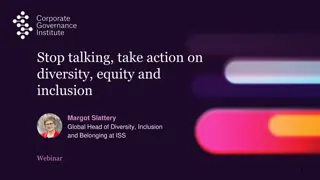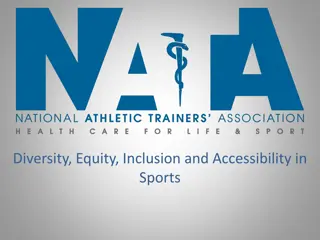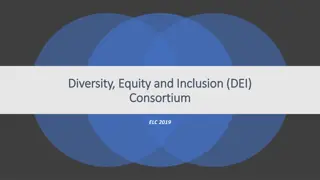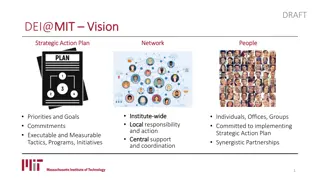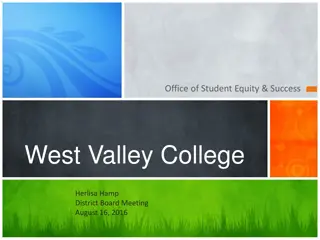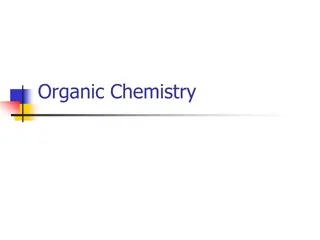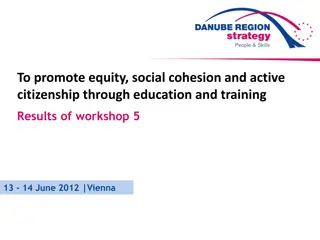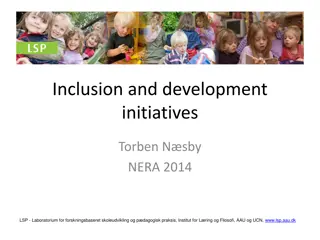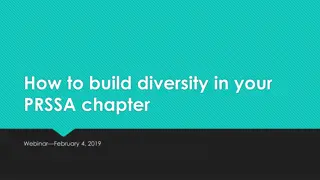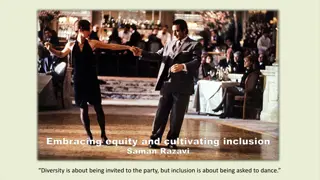Active Learning Strategies for Diversity, Equity, and Inclusion in Organic Chemistry Workshop
Explore the intersection of diversity, equity, and inclusion in organic chemistry through active learning in Jennifer Muzyka's workshop. Engage in discussions on music preferences while grading, perspectives on diversity, equity gaps in STEM classes, and strategies to address these gaps based on research findings.
Download Presentation

Please find below an Image/Link to download the presentation.
The content on the website is provided AS IS for your information and personal use only. It may not be sold, licensed, or shared on other websites without obtaining consent from the author.If you encounter any issues during the download, it is possible that the publisher has removed the file from their server.
You are allowed to download the files provided on this website for personal or commercial use, subject to the condition that they are used lawfully. All files are the property of their respective owners.
The content on the website is provided AS IS for your information and personal use only. It may not be sold, licensed, or shared on other websites without obtaining consent from the author.
E N D
Presentation Transcript
Diversity, Equity, and Inclusion Active Learning in Organic Chemistry 2022 Jennifer Muzyka
Todays Icebreaker: What music do you listen to while you re grading papers or lab reports? (I will make a spotify playlist to share with participants in this workshop.)
How does diversity relate to organic chemistry? Why do we have this session in ALOC?
How does diversity relate to organic chemistry? Why do we have this session in ALOC? Theobald et al Active learning narrows achievement gaps for underrepresented students in undergraduate science, technology, engineering, and math, PNAS 2020, 117 (12) 6476-6483.
Are there equity gaps in STEM classes at your institution? A. Yes. I have seen the data. B. Probably based on what I have seen in my classes. C. Maybe. I haven't seen the data. D. Maybe. I don't know what data would be involved. E. No. I have seen the data.
Are there equity gaps in STEM classes at your institution? How can we respond? Haak et al Increased Structure and Active Learning Reduce the Achievement Gap in Introductory Biology, Science2011, 332, 1213- 1216. Tanner, Structure Matters: Twenty-One Teaching Strategies to Promote Student Engagement and Cultivate Classroom Equity, CBE Life Sciences Education2013, 12, 322-331.
Haak et al "We show that a highly structured course design, based on daily and weekly practice with problem-solving, data analysis, and other higher- order cognitive skills, improved the performance of all students in a college-level introductory biology class and reduced the achievement gap between disadvantaged and nondisadvantaged students without increased expenditures."
Opportunities to think and talk about subject (Tanner 2013) Wait time Time to write Think-Pair-Share Don t try to do too much
Encouraging, Demanding, and Actively Managing the Participation of all Students (Tanner 2013) Hand Raising Multiple hands, multiple voices Random calling (popsicle sticks/index cards) Whip (around) Monitor student participation
Building an Inclusive and Fair Classroom Community for ALL students (Tanner 2013) Learn Students Names Integrate culturally diverse and relevant examples Work in stations or small groups Use varied active-learning strategies Be explicit about promoting access and equity for all students
Monitoring (Your Own and Students) Behavior to Cultivate Divergent Thinking (Tanner 2013) Ask open-ended questions Do not judge responses Use praise with caution Establish classroom community norms
Teaching ALL the students in your classroom (Tanner 2013) Teach them from the moment they arrive Collect assessment evidence from every student, every class
Whose mindset matters to student performance in classes? A. Faculty B. Student C. Both
Whose mindset matters to student performance in classes? Canning et al STEM faculty who believe ability is fixed have larger racial achievement gaps and inspire less student motivation in their classes, Sci. Adv. 2019, 5: eaau4734.
Growth mindset interventions Fink et al, Improving general chemistry performance through a growth mindset intervention: selective effects on underrepresented minorities, Chem. Ed. Res. Pract. 2018, 19, 783-806. Limeri et al, Growing a growth mindset: Characterizing how and why undergraduate students mindsets change, International Journal of STEM Education2020, 7, 35. Miller, When do growth mindset interventions work? Trends in Cognitive Sciences, 2019, 23, 910-912. O Leary et al, Creating inclusive classrooms by engaging STEM faculty in culturally responsive teaching workshops, International Journal of STEM Education2020, 7, 32.
How can you make your classroom more inclusive?
How can you make your classroom more inclusive? Cooper et al Fourteen Recommendations to Create a More Inclusive Environment for LGBTQ+ Individuals in Academic Biology, CBE - Life Sciences Education2020, 19:es6, 1-18. Dewsbury and Brame, Inclusive Teaching, CBE - Life Sciences Education2019, 18:fe2, 1-5. Busch et al "Unveiling Concealable Stigmatized Identities in Class: The Impact of an Instructor Revealing Her LGBTQ+ Identity to Students in a Large-Enrollment Biology Course," CBE - Life Sciences Education 2022, 21:ar37, 1-21.
Inclusive Teaching (Dewsbury and Brame) Develop self-awareness Develop empathy Classroom climate Pedagogical choices
More inclusive environment for LGBTQ+ (Cooper et al) Be thoughtful about the language used regarding LGBTQ+ community Create opportunities for people to describe who they are, avoid assuming people s identities Meaningfully advocate for the LGBTQ+ community Create an inclusive classroom Conduct research in a way that is inclusive of the LGBTQ+ community.
Faculty LGBTQ+ Identity Busch et al "Unveiling Concealable Stigmatized Identities in Class: The Impact of an Instructor Revealing Her LGBTQ+ Identity to Students in a Large-Enrollment Biology Course," CBE - Life Sciences Education 2022, 21:ar37, 1-21.
How do you motivate your students to learn chemistry?
What is culturally relevant pedagogy? For chemistry, the manner in which the subject is traditionally taught promotes the dominant culture while excluding the experiences of underrepresented minorities. This can unintentionally alienate students that are not included in the majority Utilizing teaching strategies that connect culture, real world problems, and student interests can serve to mitigate this teaching practice and promote diversity, equity, and inclusion. Younge et al Moving Beyond the Experiment to See Chemists Like Me: Cultural Relevance in the Organic Chemistry Laboratory, J. Chem. Educ. 2022, 99, 383-392.
How does student belonging influence chemistry performance?
How does student belonging influence chemistry performance? Edwards et al Relationship between Course-Level Social Belonging (Sense of Belonging and Belonging Uncertainty) and Academic Performance in General Chemistry 1, J. Chem. Educ.2021, 99, 71-82. Fink et al Belonging in general chemistry predicts first-year undergraduates performance and attrition, Chem. Educ. Res. Pract. 2020, 21, 1042-62.
Can belongingness be modified? Brady, et al A brief social-belonging intervention in college improves adult outcomes for black Americans, Sci. Adv.2020, 6: eaay3689.
Reflection prompt What changes might you make in your class(es) to make them more inclusive and/or equitable?
Brady, et al A brief social-belonging intervention in college improves adult outcomes for black Americans, Sci. Adv.2020, 6: eaay3689. Busch et al "Unveiling Concealable Stigmatized Identities in Class: The Impact of an Instructor Revealing Her LGBTQ+ Identity to Students in a Large-Enrollment Biology Course," CBE - Life Sciences Education2022, 21:ar37, 1-21. Canning et al STEM faculty who believe ability is fixed have larger racial achievement gaps and inspire less student motivation in their classes, Sci. Adv. 2019, 5: eaau4734. Cooper et al Fourteen Recommendations to Create a More Inclusive Environment for LGBTQ+ Individuals in Academic Biology, CBE - Life Sciences Education2020, 19:es6, 1-18. Dewsbury and Brame, Inclusive Teaching, CBE - Life Sciences Education2019, 18:fe2, 1-5. Edwards et al Relationship between Course-Level Social Belonging (Sense of Belonging and Belonging Uncertainty) and Academic Performance in General Chemistry 1, J. Chem. Educ.2021, 99, 71-82. Fink et al Belonging in general chemistry predicts first-year undergraduates performance and attrition, Chem. Educ. Res. Pract.2020, 21, 1042-62. Haak et al Increased Structure and Active Learning Reduce the Achievement Gap in Introductory Biology, Science2011, 332, 1213-1216. Johnson, Embracing Culturally Relevant Pedagogy to Engage Students in Chemistry: Celebrating Black Women in the Whiskey and Spirits Industry, J. Chem. Educ.2022, 99, 428-434. Tanner, Structure Matters: Twenty-One Teaching Strategies to Promote Student Engagement and Cultivate Classroom Equity, CBE Life Sciences Education2013, 12, 322-331. Theobald et al Active learning narrows achievement gaps for underrepresented students in undergraduate science, technology, engineering, and math, PNAS2020, 117 (12) 6476-6483. Younge et al Moving Beyond the Experiment to See Chemists Like Me: Cultural Relevance in the Organic Chemistry Laboratory, J. Chem. Educ.2022, 99, 383-392.
Growth mindset interventions Fink et al, Improving general chemistry performance through a growth mindset intervention: selective effects on underrepresented minorities, Chem. Ed. Res. Pract. 2018, 19, 783-806. Limeri et al, Growing a growth mindset: Characterizing how and why undergraduate students mindsets change, International Journal of STEM Education2020, 7, 35. Miller, When do growth mindset interventions work? Trends in Cognitive Sciences, 2019, 23, 910-912. O Leary et al, Creating inclusive classrooms by engaging STEM faculty in culturally responsive teaching workshops, International Journal of STEM Education2020, 7, 32.


